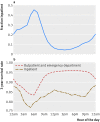Biases in electronic health record data due to processes within the healthcare system: retrospective observational study
- PMID: 29712648
- PMCID: PMC5925441
- DOI: 10.1136/bmj.k1479
Biases in electronic health record data due to processes within the healthcare system: retrospective observational study
Erratum in
-
Biases in electronic health record data due to processes within the healthcare system: retrospective observational study.BMJ. 2018 Oct 18;363:k4416. doi: 10.1136/bmj.k4416. BMJ. 2018. PMID: 30337282 No abstract available.
Abstract
Objective: To evaluate on a large scale, across 272 common types of laboratory tests, the impact of healthcare processes on the predictive value of electronic health record (EHR) data.
Design: Retrospective observational study.
Setting: Two large hospitals in Boston, Massachusetts, with inpatient, emergency, and ambulatory care.
Participants: All 669 452 patients treated at the two hospitals over one year between 2005 and 2006.
Main outcome measures: The relative predictive accuracy of each laboratory test for three year survival, using the time of the day, day of the week, and ordering frequency of the test, compared to the value of the test result.
Results: The presence of a laboratory test order, regardless of any other information about the test result, has a significant association (P<0.001) with the odds of survival in 233 of 272 (86%) tests. Data about the timing of when laboratory tests were ordered were more accurate than the test results in predicting survival in 118 of 174 tests (68%).
Conclusions: Healthcare processes must be addressed and accounted for in analysis of observational health data. Without careful consideration to context, EHR data are unsuitable for many research questions. However, if explicitly modeled, the same processes that make EHR data complex can be leveraged to gain insight into patients' state of health.
Published by the BMJ Publishing Group Limited. For permission to use (where not already granted under a licence) please go to http://group.bmj.com/group/rights-licensing/permissions.
Conflict of interest statement
Competing interests: All authors have completed the ICMJE uniform disclosure form at www.icmje.org/coi_disclosure.pdf and declare: all authors had financial support from the National Institutes of Health for this study.
Figures




References
-
- National Research Council. The Learning Healthcare System: Workshop Summary (IOM Roundtable on Evidence-Based Medicine). Washington, DC: The National Academies Press, 2007. - PubMed
-
- Centers for Medicare & Medicaid Services (CMS). "EHR Incentive Programs". http://www.cms.gov/Regulations-and-Guidance/Legislation/EHRIncentiveProg....
Publication types
MeSH terms
Grants and funding
LinkOut - more resources
Full Text Sources
Other Literature Sources
Medical
